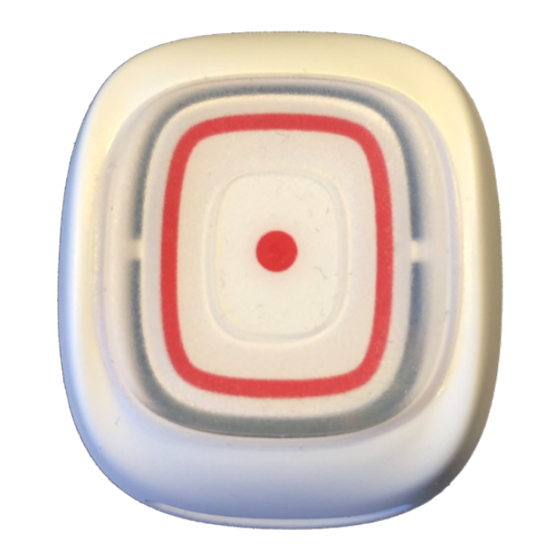
Table of Contents
Advertisement
Advertisement
Table of Contents

Summary of Contents for Neat SMILE
- Page 1 SMILE User manual NE41 14002-02 v2.0...
- Page 2 NEAT Electronics AB Varuvägen 2 Hereby NEAT Electronics AB declares that the SE-246 42 Löddeköpinge radio equipment type SMILE is in compliance Sweden with Directive 2014/53/EU. The full text of the Phone: +46 (046) 707065 EU declaration of conformity is available at...
-
Page 3: Table Of Contents
Changing the top shell SMILE Programmer The drop down menus 7.1.1 File 7.1.2 Communication 7.1.3 Help Button and Alarm types 7.2.1 Button functions 7.2.2 Alarm Types Radio 7.3.1 Radio ID Code, Alarm Delay 7.3.2 Radio transmission SMILE User manual NE41 14002-02 v2.0... - Page 4 Info Activity RFID RFID zones/codes 7.7.1 Codes and zones with continous retransmission Battery holder Use and maintenance Safety notes Use Use only original parts. Do not expose to direct sunlight. Cleaning Recycling Technical data SMILE User manual NE41 14002-02 v2.0...
-
Page 5: About Smile
D-POS, DPOS-II or D-SERVER system. General Use SMILE is to be carried by the user, either in a necklace or on a wrist- band. An alarm button enables the possibility to trigger an alarm manually. The alarm is trigged by a light touch on the red alarm button and the alarm is acknowledged by blinking green. -
Page 6: Smile
SMILE Denomination Alarm button SMILE parts Denomination SMILE Unit (with red alarm button) SMILE PIN (with latch and necklace) SMILE CLIP (Optional) Necklace with PIN Wristband SMILE User manual NE41 14002-02 v2.0... -
Page 7: Led Indications
SMILE or SMILE-ID. BERLOCK The berlock trim is an accessory and is used to reduce the user feelings stigmatizing. SMILE User manual NE41 14002-02 v2.0... -
Page 8: Mounting
Thread the wristband through the holes and attach on arm. CLIP Fix CLIP on the back of the SMILE, thread the PIN trough the holes on the SMILE until the latch clicks in place. To detach the CLIP, press the PIN latch and remove the PIN. -
Page 9: Berlock
PIN. Changing the top shell The SMILE design allows for replacement of the top shell. Remove the top shell by gently pulling the wristband holes outwards. Attach the new top shell and press until a distinct “click” is heard. -
Page 10: The Drop Down Menus
The drop down menus 7.1.1 File Press New to select a new standard configuration for a SMILE or SMILE ID. Open..., Save, Save As... The options Open..., Save, Save As... and Change default config should be quite self-explanatory and is for handling configuration files. -
Page 11: Communication
The general procedure for obtaining the configuration is: • Start the reading process in SMILE-ID Programmer. • Press the alarm button to connect the SMILE-ID with the programmer. • Pressing the alarm button a second time to read actual configura- tion. -
Page 12: Help
This drop down item displays the software version and firmware ver- sion of the connected NPU. The information displayed is read-only. Button and Alarm types The Button and Alarm types tab is divided into two sections: • Button functions • Alarm Types SMILE User manual NE41 14002-02 v2.0... -
Page 13: Button Functions
7.2.1 Button functions SMILE supports a number of different press types, i.e. how the alarm button is pressed. By default Normal press is always enabled. Normal press enabled A normal press is when the alarm button is pressed and kept pressed for max. -
Page 14: Radio
For users who frequently presses the alarm button, hence trigging many alarms within a short time, the option to block user alarms is very convenient. A value 0 (zero) blocks the transmission during 4 seconds. SMILE User manual NE41 14002-02 v2.0... -
Page 15: Radio Transmission
Even if the device receives the ACK the unit will send all the bursts configured. Radio frequency band To select the region frequency. Equipment type To identify the equipment that connects with NPU. Do not change this parameter. SMILE User manual NE41 14002-02 v2.0... -
Page 16: Info
Info This is a read-only window displaying technical data from the read unit. Activity The SMILE-ID unit has been built with an accelerometer intended to detect either inactivity or activity and automatically send an alarm if this occurs. Activity enable Check box to activate activity sense, i.e. -
Page 17: Rfid
(in seconds). Radio inactivity period after transmit (s) When the SMILE-ID has transmitted a message the unit will not send any messages from the same position for a period of time in order to save battery power and this period is set here (in seconds). -
Page 18: Rfid Zones/Codes
Check this box whether the unit is a personnel device or not. Transmit extended message If the receiver needs more information than normal the SMILE-ID can be configured to send extended messages. The information included in an extended messages is: •... - Page 19 (s) to 10 This will result in: A SMILE-ID entering a zone (e.g. Zone 1) will transmit when entering the zone and will never re-transmit unless leaving the zone AND entering another zone (other than Zone 1) before returning to this zone (Zone 1).
-
Page 20: Battery Holder
• Do not clean the device with harsh chemicals, solvents or other corrosive substances. Recycling Dispose of properly. The worn out product must be returned to a recycling facility for proper disposal or returned to NEAT. SMILE User manual NE41 14002-02 v2.0... -
Page 21: Technical Data
869.2 MHz (Social alarms) Category 1 RF Frequency - Non EU* 866.2, 868.2, 906.2, 916.2 MHz RFID frequency 125 kHz Battery life > 5 years IP Class IP67 Temperature range +5 - +55 °C *According to local regulations SMILE User manual NE41 14002-02 v2.0... - Page 22 This page is intentionally left blank. SMILE User manual NE41 14002-02 v2.0...
- Page 23 This page is intentionally left blank. SMILE User manual NE41 14002-02 v2.0...
- Page 24 www.neat-group.com...

